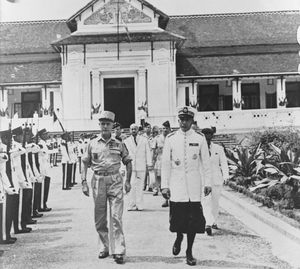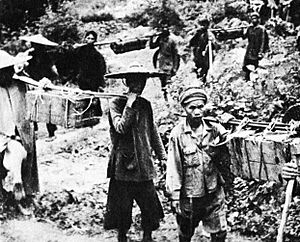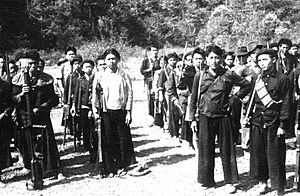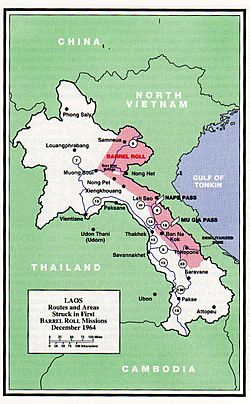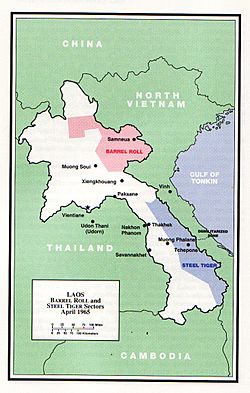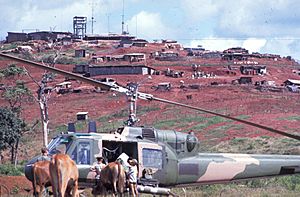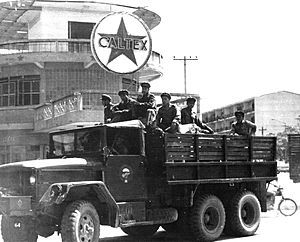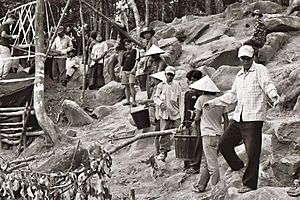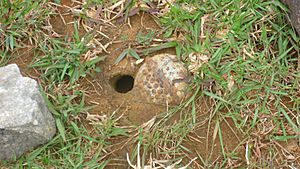Laotian Civil War facts for kids
Quick facts for kids Laotian Civil War |
|||||||
|---|---|---|---|---|---|---|---|
| Part of the Vietnam War, the Indochina Wars, and the Cold War | |||||||
 Areas of Laos controlled by the Pathet Lao and bombed by the United States Air Force in support of the Kingdom of Laos. |
|||||||
|
|||||||
| Belligerents | |||||||
|
Supported by:
|
Supported by:
|
||||||
| Commanders and leaders | |||||||
| Strength | |||||||
| Casualties and losses | |||||||
| 20,000–62,000 total dead | |||||||
The Laotian Civil War (1959–1975) was a long conflict in Laos. It was fought between the Communist group called the Pathet Lao and the Royal Lao Government. This war was closely linked to the Vietnam War and the Cambodian Civil War. Both sides in Laos received a lot of help from other countries, making it a "proxy war" during the global Cold War. In America, it was often called the Secret War because many details were kept hidden.
Laos was officially a neutral country, but it became a secret battleground during the Vietnam War. After France gave Laos its independence in 1953, the new government did not include everyone. This led to different groups fighting for control. There were neutralists, right-wing groups, and the left-wing Pathet Lao. They tried to form governments together, but the fighting continued.
The war involved soldiers from North Vietnam, the United States, Thailand, and South Vietnam. North Vietnam used parts of Laos for its Ho Chi Minh trail, which was a supply route for troops and weapons going into South Vietnam. Another important battle area was the Plain of Jars in northern Laos.
In 1975, the North Vietnamese and Pathet Lao won the war. This was part of a bigger victory for communist forces across Indochina. After the Pathet Lao took over, many people from Laos, especially the Hmong people, fled to Thailand. The Hmong had helped the Americans, and the new government treated them very harshly. Many members of the Lao royal family were also arrested and sent to special camps, where many did not survive.
Contents
- Understanding the Secret War
- Key Events of the Laotian Civil War
- The Start of the Conflict (1945-1952)
- North Vietnamese Invasion and French Defeat (1953-1954)
- A Brief Calm and Growing Tensions (1955-1958)
- North Vietnamese Invasion and Coup (1959-1960)
- Deepening Involvement (1961-1963)
- U.S. Air Force Joins the Fight (1964-1968)
- Continued Fighting and Peace Talks (1969-1972)
- The End of the War (1973-1975)
- Evacuation of the Hmong People
- What Happened After the War
- See also
Understanding the Secret War
The 1954 Geneva Conference declared Laos a neutral country. However, the People's Army of Vietnam (PAVN) from North Vietnam continued to operate there. They built the Ho Chi Minh trail in southeastern Laos. This trail was a major highway used to move North Vietnamese soldiers and supplies to South Vietnam.
North Vietnam also supported the Pathet Lao, a communist group in Laos. The Pathet Lao put pressure on the Royal Lao Government. To counter this, the U.S. Central Intelligence Agency (CIA) secretly trained a guerrilla force of about 30,000 Laotian tribesmen. Most of these were Hmong people, led by General Vang Pao. This secret army was supported by the CIA's own airline, Air America, and the Royal Thai Air Force. They fought against the North Vietnamese and Pathet Lao.
The fighting in northern Laos often depended on the weather. During the dry season, North Vietnamese forces would advance. The CIA's secret army would fight back, and U.S. planes would launch air strikes. When the rainy season made supply lines difficult, the Vietnamese forces would retreat.
In southeastern Laos, the war focused on bombing the Ho Chi Minh Trail. U.S. planes carried out massive air attacks because ground troops could not easily enter from South Vietnam. The U.S. kept its involvement in Laos a secret because it had signed agreements to keep Laos neutral. However, North Vietnam was also secretly active in Laos. This "Secret War" became the largest U.S. covert operation before the Soviet-Afghan War. Laos was bombed heavily, making it one of the most bombed countries in history.
Key Events of the Laotian Civil War
The Start of the Conflict (1945-1952)
After World War II, Laos faced political confusion. The French wanted to regain control, while a group called Lao Issara (Free Laos) wanted independence. This group included three princes: Phetsarath Ratanavongsa, Souvanna Phouma, and Souphanouvong. Souphanouvong became a key leader of Lao Issara and later allied with North Vietnam.
In 1946, the French returned and defeated Lao Issara. Many members fled, but a splinter group led by Thao O Anourack went to Hanoi. There, with help from Ho Chi Minh's allies, they formed the military movement that became the Pathet Lao.
In 1947, Laos became an independent nation within the French Union. It began building its own army, the Armée Nationale Laotienne (later the Royal Lao Army). However, this army was still heavily influenced by the French. Meanwhile, the Pathet Lao grew stronger with support from North Vietnam.
North Vietnamese Invasion and French Defeat (1953-1954)
In April 1953, North Vietnam's army, with 40,000 troops, invaded northeastern Laos. They were joined by 2,000 Pathet Lao soldiers. Their goal was to capture the royal capital of Luang Prabang and the Plain of Jars. The North Vietnamese took control of border provinces and allowed the Pathet Lao to occupy the land.
This invasion marked the beginning of the civil war in Laos, even while the First Indochina War was still going on. The French tried to defend Laos, but their forces were stretched thin.
The famous Battle of Dien Bien Phu in Vietnam (March-May 1954) was very close to the Lao border. The U.S. secretly flew supplies to the French during this battle. When the French lost at Dien Bien Phu, it ended the First Indochina War. An agreement was signed on July 20, 1954, giving Laos its independence. However, the Laotian Civil War continued.
A Brief Calm and Growing Tensions (1955-1958)
After independence, the U.S. began providing military aid to the Royal Lao Government. The U.S. paid for almost all of Laos's military budget. To do this secretly, the U.S. set up the Programs Evaluation Office (PEO), staffed by American civilians with military backgrounds.
In 1957, a coalition government was formed that included the Pathet Lao. However, tensions remained high. The Pathet Lao and North Vietnam continued to recruit and train soldiers. The U.S. also increased its support for the Royal Lao Army and began arming Hmong guerrillas.
North Vietnamese Invasion and Coup (1959-1960)
In May 1959, North Vietnam created Group 559 to manage the Ho Chi Minh trail. This trail was vital for moving war supplies to South Vietnam.
The Pathet Lao troops were supposed to join the national army, but they refused. Their leader, Souphanouvong, was arrested but later escaped. In July, U.S. Special Forces began secretly training the Royal Laotian Army. North Vietnamese units then attacked along the border, pushing back the Royal Lao Army.
In August 1960, Captain Kong Le led a bloodless coup in Vientiane. He wanted to end the fighting and foreign interference. However, his coup led to more conflict. General Phoumi Nosavan, with CIA support from Thailand, launched a counter-coup. The Soviet Union began flying in military supplies to support Kong Le's neutralists and the Pathet Lao.
By December, Phoumi's forces attacked Vientiane. Kong Le and his neutralists retreated north to the Plain of Jars. This led to Kong Le's forces joining with the Pathet Lao. By the end of 1960, Laos had become a major battleground for the world's superpowers.
Deepening Involvement (1961-1963)
In January 1961, the new alliance of Kong Le's neutralists, Pathet Lao, and North Vietnamese forces pushed the Royal Lao Army from the Plain of Jars. The U.S. responded by air-dropping weapons to 7,000 Hmong guerrillas. The U.S. also increased its training efforts.
In May 1962, a major defeat for the Royal Lao Government at Nam Tha forced the U.S. and other countries to push for a new coalition government with the Pathet Lao. Foreign military advisors were supposed to leave Laos. The U.S. withdrew its military mission, but North Vietnam did not remove most of its forces.
By mid-1963, the Pathet Lao and neutralists began fighting each other. The neutralist group split. Fighting between the Pathet Lao and government troops soon started again. The U.S. secretly re-established its military advisory group in Thailand to continue supporting Laos.
U.S. Air Force Joins the Fight (1964-1968)
In 1964, the U.S. Air Force began training Lao pilots in Thailand. This was a way around the treaty that banned training in Laos. The Royal Laotian Air Force also started using Thai volunteer pilots.
In May 1964, the U.S. Air Force began flying reconnaissance and bombing missions over Laos, called "Yankee Team." These missions gathered information on the Ho Chi Minh Trail. By December, bombing operations over northern Laos, called Operation Barrel Roll, began. All targets had to be approved by the U.S. ambassador.
In 1965, the U.S. started Operation Steel Tiger over the Laotian panhandle to destroy enemy forces and supplies on the Ho Chi Minh Trail. Later that year, Operation Tiger Hound focused airpower on a small, heavily used part of the trail. For the first time, B-52 bombers were used in Laos.
From 1965 to 1973, the civil war in northern Laos saw intense but short battles. In 1968, North Vietnam launched a major attack on the Royal Lao Army at Nam Bac. This defeat severely weakened the Royal Lao Army, leaving mostly tribal irregulars to fight. The U.S. also launched Operation Commando Hunt to bomb the Ho Chi Minh Trail, but it had limited success.
Continued Fighting and Peace Talks (1969-1972)
In March 1969, the Royal Lao Army launched a large attack in the Plain of Jars, supported by U.S. air power. The fighting went back and forth, with both sides gaining and losing ground. North Vietnamese forces, including the 316th and 312th Infantry Divisions, heavily supported the Pathet Lao.
In 1971, South Vietnam launched Operation Lam Son 719 into Laos to cut the Ho Chi Minh Trail. The U.S. provided massive air support, but no ground troops. The South Vietnamese faced strong resistance and had to withdraw after heavy losses.
By November 1972, the Pathet Lao agreed to meet with the Laotian government to discuss a ceasefire. The war had created a large number of refugees, with nearly 380,000 people displaced from their homes by 1973.
The End of the War (1973-1975)
The U.S. pulled out of Laos in 1973, as part of the Paris Peace Accord. However, North Vietnam was not required to remove its forces. The national government in Laos was forced to accept the Pathet Lao into the government.
During 1974 and 1975, the Pathet Lao grew stronger as the U.S. withdrew from Indochina. The anti-communist forces in Laos became divided and weakened. The Pathet Lao, supported by North Vietnam, gained more control.
In March 1975, North Vietnam launched its final offensive in South Vietnam, leading to the fall of Saigon. The Pathet Lao knew victory was near. They began advancing westward. Many right-wing ministers and military leaders fled the country. Prime Minister Souvanna Phouma, hoping to avoid more conflict, told his forces not to resist. The U.S. began to withdraw its diplomatic staff.
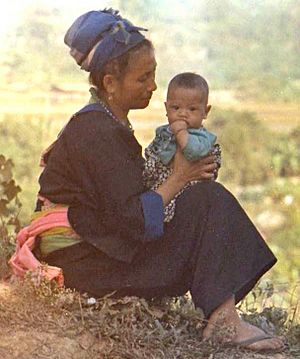
In May, the Pathet Lao army entered major towns in southern Laos. In June, they took Luang Prabang. Many people, especially those who had worked with the U.S., panicked and fled to Thailand. General Vang Pao led thousands of his Hmong fighters and their families into exile.
In August, Pathet Lao forces captured Vientiane. On December 2, 1975, King Savang Vatthana gave up his throne, and Souvanna Phouma resigned. The Lao People's Democratic Republic was declared, with Souphanouvong as President. Kaysone Phomvihane became Prime Minister and the real leader.
The Pathet Lao then stopped pretending to be moderate. Non-communist newspapers were closed, and many people from the civil service, army, and police were sent for "re-education" in remote areas. Many died or were held for years. A large number of educated people and professionals also left Laos. About 300,000 people, out of a population of 3 million, fled to Thailand.
Evacuation of the Hmong People
A very dramatic event at the end of the war was the evacuation of General Vang Pao and other Hmong leaders from Long Tieng. On May 5, 1975, Vang Pao was told to cooperate with the Pathet Lao. He refused and decided to leave. Four days later, the Pathet Lao newspaper warned that the Hmong people would be "exterminated."
Jerry Daniels, Vang Pao's CIA contact, was the only American left in Long Tieng. He quickly planned an evacuation for 3,500 Hmong leaders and their families who were in danger. With help from other American civilians and planes, the evacuation began on May 13. Each plane carried many more people than was safe, flying from Long Tieng to Thailand.
Thousands of Hmong gathered at the airstrip, hoping to escape. On May 14, Vang Pao and Jerry Daniels were secretly flown out by helicopter to Thailand. The air evacuation then ended. The next day, the Pathet Lao marched into Long Tieng without a fight.
Many Hmong people who were left behind followed Vang Pao to Thailand. By the end of 1975, about 40,000 Hmong had reached Thailand by walking through mountains and crossing the Mekong River. Many died trying to escape. The Hmong faced harsh treatment from the new communist government for helping the Americans. Most Hmong refugees in Thailand were later resettled in the United States and other countries.
What Happened After the War
The Laotian Civil War is often forgotten because of the larger Vietnam War. However, it had a huge impact on Laos.
On May 15, 1997, the U.S. officially recognized its role in the "Secret War." A memorial was built near the Arlington National Cemetery to honor the American and Hmong people who helped in the conflict.
Helping Hmong Veterans
Many Hmong and Laotian veterans and their families worked to get honorary U.S. citizenship for the "Secret Army" veterans. In 2000, the U.S. Congress passed the Hmong Veterans' Naturalization Act, which President Bill Clinton signed into law.
Some Hmong people surrendered to the Lao government, while others went to refugee camps in Thailand. In 2008, a deal between Thailand and Laos led to many Hmong being forced back to Laos. However, in 2004, the U.S. government changed its policy and allowed about 15,000 Hmong who had fled Laos in the 1990s to come to the U.S. as political refugees.
Unexploded Bombs
The U.S. dropped a huge amount of bombs on Laos between 1965 and 1973—more than on all countries during World War II. This left Laos with about 78 million pieces of unexploded ordnance (UXO). About 30% of the bombs did not explode when they were dropped.
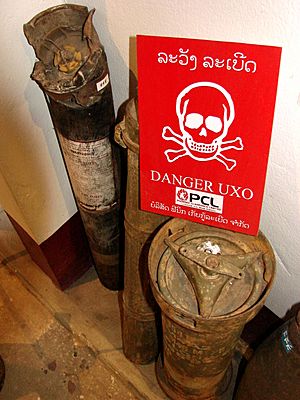
These unexploded bombs are still very dangerous. They continue to cause injuries and deaths. From 1964 to 1975, about 30,000 people were killed or injured by bombs. Since the war ended, another 20,000 people have been affected by UXO. Many people in Laos, especially in the Plain of Jars, collect and sell scrap metal from these bombs as a way to make a living. About 50 people are still killed or injured by UXO every year.
See also
 In Spanish: Guerra civil de Laos para niños
In Spanish: Guerra civil de Laos para niños


